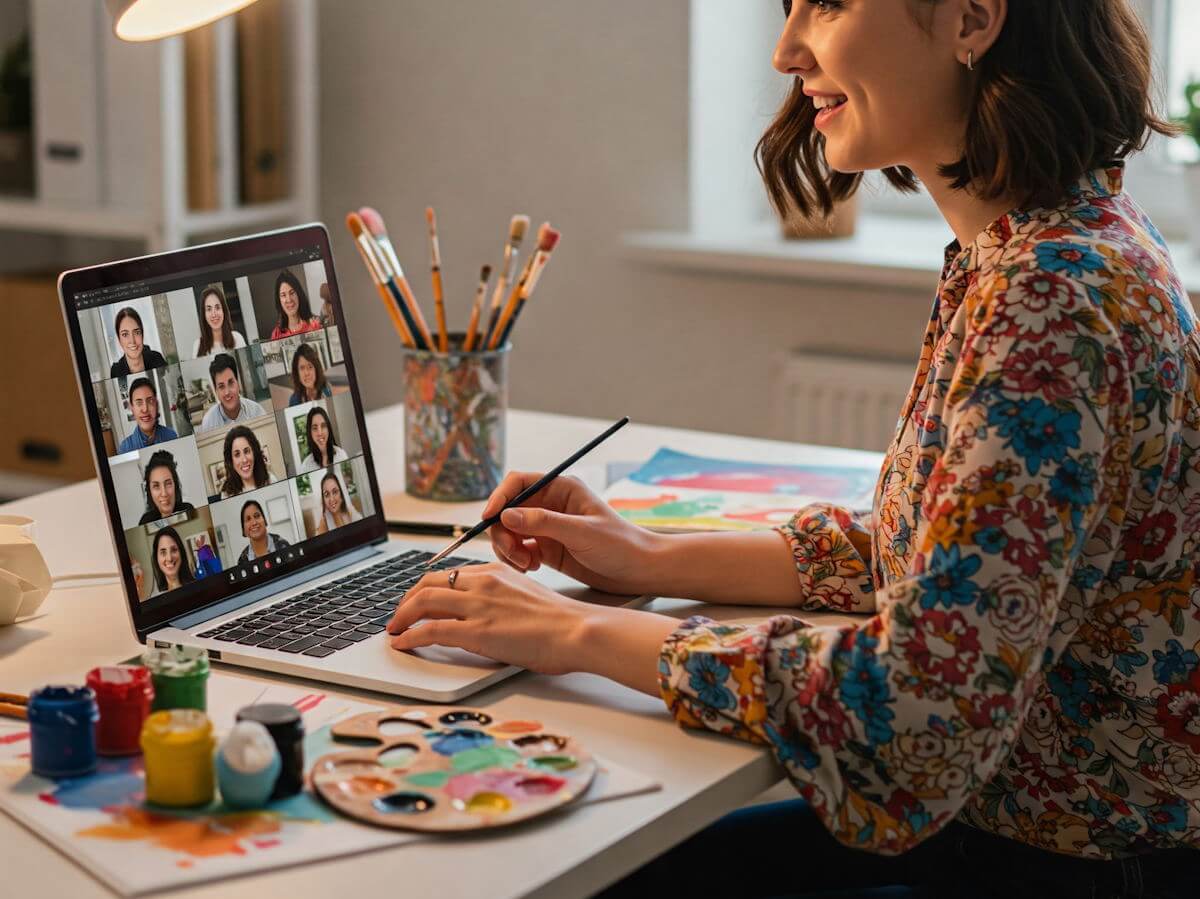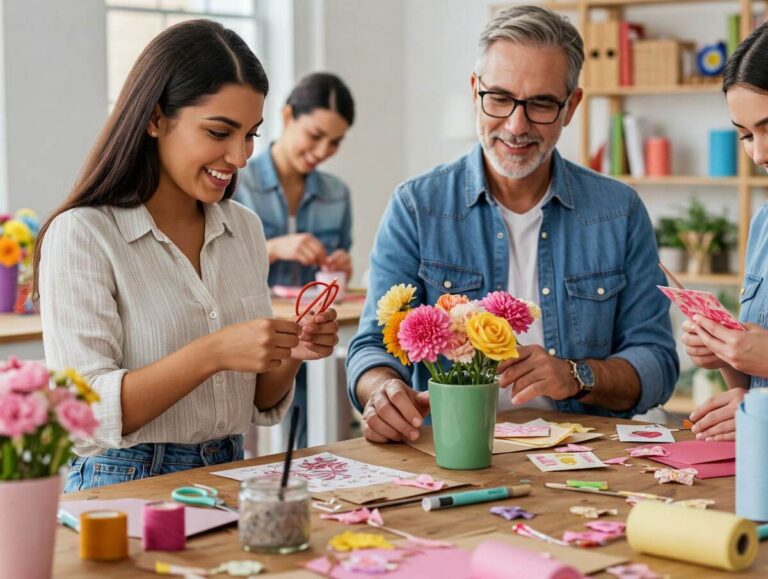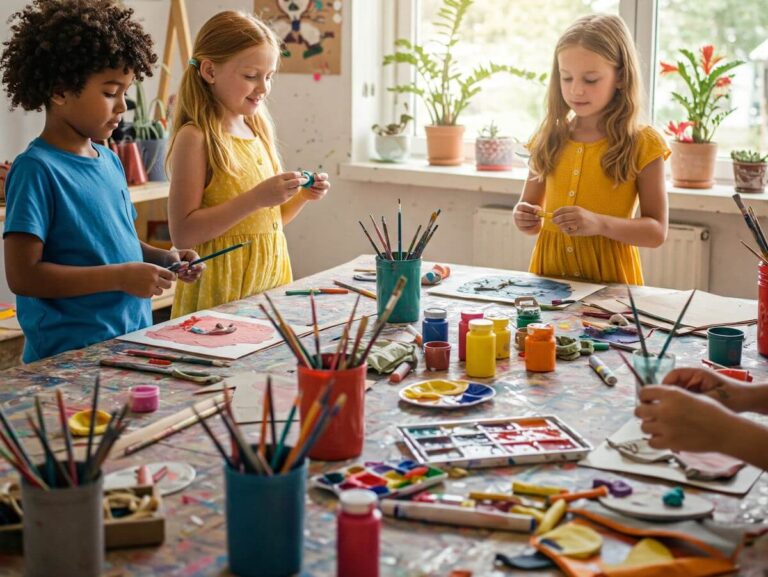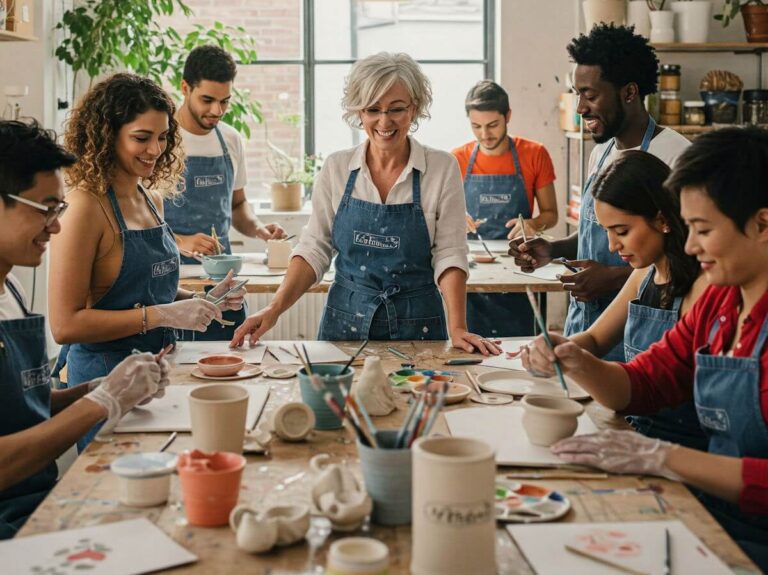In recent years, the art community has witnessed a significant transformation with the emergence of online art workshops. This shift to a virtual format has become an essential tool for artists and educators, allowing them to adapt to the ever-evolving digital landscape. Online art workshops not only provide an opportunity for artists to impart their skills but also facilitate learning and collaboration among participants from diverse geographical locations.
One of the foremost benefits of hosting art workshops online is the ability to reach a wider audience. Unlike traditional in-person sessions that are often confined to local attendees, virtual platforms eliminate geographical barriers. Artists can now connect with eager learners from across the globe, fostering a rich exchange of ideas and techniques. This expansion of reach is particularly beneficial for emerging artists who may not have the resources to travel or for those who live in remote areas with limited access to art instruction.
Flexibility is another significant advantage of online art workshops. Participants can join sessions at their convenience, allowing them to balance their artistic pursuits with personal and professional commitments. Furthermore, recorded workshops can often be revisited for reinforcement of techniques learned. This convenience caters to various learning styles, as participants can engage with content at their own pace, leading to a more personalized educational experience.
Additionally, the digital environment enhances opportunities for creativity and collaboration. Online platforms often facilitate interactive tools such as virtual whiteboards, allowing for real-time feedback and peer interaction. This collaborative spirit can ignite inspiration among participants, as they share their projects and techniques. Overall, online art workshops represent a dynamic evolution in art education, merging creativity with technology in innovative ways.
Choosing the Right Platform
When planning to host an online art workshop, selecting the appropriate platform is crucial for ensuring a seamless experience for both the instructor and attendees. Various options are available, each offering distinct features tailored to different needs. Popular platforms like Zoom and Microsoft Teams have gained traction due to their user-friendly interfaces and robust functionalities.
Zoom is particularly favored for its ease of use and reliability. It allows for screen sharing, enabling instructors to showcase their artwork or demonstrate techniques in real-time. Additionally, Zoom’s breakout rooms provide an opportunity to foster individual or small group interactions, which can be particularly beneficial during art exercises or critiques. Moreover, the option to record sessions is invaluable as it allows participants to revisit the material at their leisure, enhancing the overall learning experience.
On the other hand, Microsoft Teams integrates well with organizational tools and is ideal for workshops tailored to corporate or institutional settings. It offers similar features to Zoom, including screen sharing and document collaboration, while also benefitting from a structured environment that may be preferred by certain audiences.
For those seeking a more educational-focused approach, platforms like Skillshare and Teachable are designed specifically for teaching and learning. These platforms allow for the creation of course materials that can be accessed asynchronously, enabling learners to progress at their own pace. However, they may lack some real-time interaction features that live sessions provide.
Cost is another consideration when choosing the right platform. While some tools are free, others offer subscription models that could be a barrier for small or independent artists. Therefore, assessing each platform’s features, usability, and associated costs can help ensure you select the ideal environment for your online art workshop.
Essential Tools and Equipment
Hosting an online art workshop requires careful consideration of the tools and equipment utilized by both the host and participants. The selection of appropriate hardware plays a pivotal role in ensuring a smooth and effective workshop experience. For the host, having a reliable computer or tablet with sufficient processing power is essential. These devices should ideally support high-resolution graphics to facilitate the use of design software and online art tools, ensuring that the instructions and demonstrations can be clearly communicated to participants.
In addition to personal computing devices, a high-quality camera is crucial for the host to demonstrate techniques effectively. A web camera with at least 1080p resolution will offer participants a clear view of the artistic processes being discussed. Furthermore, employing a good microphone will enhance the audio quality during sessions, minimizing the chances of communication breakdown due to poor sound quality.
On the participants’ side, it is equally important that they have access to functional hardware. Participants should also have a computer or tablet that supports the necessary software applications to engage fully in the workshop activities. If the workshop involves drawing or painting digitally, using a graphic tablet could significantly enhance their experience.
Equally vital is the selection of software. Popular graphic design programs, like Adobe Creative Suite or free alternatives such as GIMP, provide necessary tools for creativity during the workshop. Online art tools like Procreate or ArtRage can also be beneficial for those engaged in digital art. Establishing stable internet connectivity is paramount for both hosts and attendees, as poor connection can lead to interruptions and disruptive experiences. Lastly, both parties should ensure they are working in a quiet workspace to facilitate focus and engagement throughout the workshop.
Designing an Engaging Workshop Curriculum
Creating an engaging curriculum for an online art workshop requires careful consideration of various elements that foster interaction and enthusiasm among participants. The first step in this process is to set clear objectives that outline what attendees will learn and achieve during the session. Establishing specific goals not only provides direction but also helps participants understand the value of their commitment. For example, clear objectives might include mastering a particular technique or developing a unique project by the end of the workshop.
Next, selecting the right art techniques to teach plays a crucial role in the success of the workshop. It is essential to choose techniques that are not only relevant to the workshop theme but also suitable for the skill levels of the participants. This ensures that everyone feels challenged yet capable of completing the tasks, which helps maintain motivation throughout the session. Incorporating a diverse range of techniques can also cater to varying interests and backgrounds among participants, allowing for a richer learning experience.
Furthermore, interactive activities are vital in keeping the energy up and ensuring participants remain engaged. Live demonstrations can serve as an effective tool for teaching, giving participants a visual guide to follow. Similarly, incorporating opportunities for participant feedback allows individuals to share their thoughts and experiences, fostering a sense of community within the workshop. Collaborative activities, such as group discussions or joint projects, also enhance interaction and keep the energy vibrant. By encouraging participants to connect and share, you create an environment that promotes both learning and creativity.
Overall, designing an engaging curriculum involves a combination of clear objectives, appropriate techniques, and interactive elements. By thoughtfully planning these components, you can create an enjoyable and inspiring online art workshop that motivates and educates participants effectively.
Marketing Your Online Workshop
Effectively marketing your online art workshop is crucial for attracting participants and ensuring a successful event. To begin with, harness the power of social media. Platforms like Instagram, Facebook, and Pinterest are particularly suited for visual content, making them ideal for promoting art workshops. Create an engaging presence by sharing behind-the-scenes images, engaging videos, or testimonials from previous participants. Use relevant hashtags to widen your reach, allowing potential attendees to discover your workshop organically.
Additionally, leveraging email newsletters can be a highly effective strategy. Build a mailing list of interested individuals by offering a free resource or mini-class related to your workshop topic. Regularly communicate with this audience via well-crafted newsletters that highlight what they can expect from your workshop, including details on materials needed, skill levels welcomed, and key learning outcomes. Consider including an early-bird discount to encourage early sign-ups and increase overall attendance.
Engaging with art communities, both online and offline, is another effective technique for promoting your workshop. Platforms such as Reddit, various Facebook groups, and dedicated art forums are treasure troves of like-minded individuals who may be interested in your offerings. Participate in discussions, share your expertise, and subtly promote your workshop when appropriate. This will not only help you build credibility but also generate community interest in your event.
When it comes to pricing your workshop, consider the value you’re offering. Research similar workshops to ensure your pricing aligns with market standards while also reflecting your expertise. Create appealing visuals that represent the essence of your workshop, as they will play a significant role in attracting attendees. Finally, write compelling descriptions that convey not just the logistical details but also the emotional impact of attending your online workshop. Your marketing efforts should focus on conveying the transformative experience potential participants can expect.
Creating a Welcoming Online Environment
In any online art workshop, fostering a welcoming atmosphere is crucial for encouraging creativity and participation among participants. One of the first steps toward achieving this is to establish clear ground rules for communication. Before the workshop begins, it is essential to communicate expectations regarding respect, listening, and engagement. Reminding participants to maintain a supportive language and to refrain from interrupting others can pave the way for a respectful dialogue. This clarity can set a positive tone for the entire workshop and ensure everyone feels comfortable expressing their ideas.
Additionally, incorporating icebreakers into the initial stages of the workshop effectively helps participants connect with one another. Icebreaker activities can be simplistic yet engaging, such as asking participants to share their favorite art medium or to describe their artistic inspirations. By doing so, participants begin to interact and find commonalities, reducing feelings of isolation that may arise in an online setting. This not only builds camaraderie but also fosters a sense of belonging, which is beneficial for a collaborative learning experience.
Furthermore, positive reinforcement and constructive feedback play pivotal roles in creating an encouraging environment. It is essential to celebrate participants’ efforts and progress, no matter how small. Complimenting their works, encouraging peer-to-peer feedback, and gently guiding them toward improvements can enhance their confidence and motivation. Establishing a culture where constructive criticism is shared positively enables participants to view feedback as a tool for growth rather than criticism. Through these methods, an online art workshop can develop into a vibrant, engaging environment that nurtures each participant’s artistic journey.
Handling Technical Difficulties
When hosting an online art workshop, it is essential to anticipate potential technical difficulties that may arise during the session. Understanding how to effectively respond to these issues can not only save time but also maintain a professional atmosphere for your participants. One of the most common problems includes internet connectivity issues. To mitigate this, ensure you have a stable connection, ideally through a wired Ethernet setup. If using Wi-Fi, position yourself close to the router and inform participants at the start of the workshop to check their connection status if they encounter any lag.
Audio and visual glitches can also disrupt the flow of the workshop. To address audio issues, it is advisable to invest in a good quality microphone and headset to improve sound clarity. Prior to the workshop, conduct a test run to check audio quality and familiarize yourself with the software features, such as mute and unmute. In the event of sound problems, utilize the chat function to communicate, allowing participants to ask questions or provide feedback without interrupting the session.
Furthermore, software failures may occur unpredictably. Be prepared with a backup plan; consider having an alternative platform ready or ensure you have directions for participants on how to reconnect if there are problems. Additionally, maintain a sense of composure and professionalism when facing technical challenges. A calm response can significantly decrease participant frustration. It is beneficial to keep a list of troubleshooting tips or a support contact handy, allowing you to quickly handle issues as they arise. Ultimately, effective handling of technical difficulties enhances the overall experience for both the host and the participants in the online workshop.
Post-Workshop Follow-Up
After hosting an online art workshop, the follow-up communication plays a crucial role in reinforcing the experience for participants and fostering ongoing engagement. Effective follow-up serves several purposes, including gathering valuable feedback, sharing additional resources, and promoting an active community around the workshop theme. These actions contribute to enhancing the overall quality of future sessions and ensuring participants feel appreciated and motivated.
One of the primary methods for collecting feedback is through post-workshop surveys. Utilizing online survey tools allows facilitators to easily create questionnaires that address various aspects of the workshop, such as content relevance, presentation clarity, and participant engagement. This feedback not only provides insights into participant satisfaction but also informs necessary adjustments to improve future workshops. Tools like Google Forms or SurveyMonkey can be effective for this purpose, allowing for quick analysis of responses.
Subsequently, sharing additional resources can significantly enrich the participants’ learning experience. Providing a curated list of materials, such as instructional videos, articles, or downloadable templates related to the workshop topic can reinforce concepts covered during the session. Consider also sharing a recording of the workshop itself, enabling participants to revisit the content at their own pace and absorb the material more thoroughly.
Furthermore, encouraging continued engagement is essential for building a thriving community. Creating online forums or social media groups dedicated to participants can foster collaboration and discussion around their artistic endeavors. Inviting individuals to share their work or participate in future workshops enhances communal bonds, ultimately enriching the overall experience. Regularly hosting follow-up events or additional workshops can maintain momentum and enthusiasm among participants, creating a vibrant learning environment.
Success Stories and Case Studies
In recent years, numerous artists and organizations have successfully transitioned their art workshops from physical spaces to online platforms, showcasing the immense potential of virtual art education. One remarkable success story is that of a community art center that adapted its programs to a virtual format in response to the COVID-19 pandemic. By leveraging Zoom and various social media platforms, they were able to reach an audience beyond their local community. Their workshops included everything from painting and drawing to digital art, accommodating different skill levels.
Participants reported not only an improvement in their artistic skills but also a sense of community, as they connected with fellow artists from across the globe. Feedback from attendees highlighted how they appreciated the flexibility of online workshops, allowing them to join sessions tailored to their personal schedules. This center’s ability to host guest artists from diverse backgrounds enriched the learning experience and showcased the diverse expressions found in the art world.
Another inspiring example comes from an established artist who pivoted to online teaching by offering a series of Masterclasses. By utilizing video tutorials combined with interactive live sessions, she was able to provide in-depth instruction while creating a dynamic learning environment. Participants praised her approach, noting that the pre-recorded material allowed for self-paced learning, while live Q&A sessions added personalized feedback. This method not only garnered her a wider audience but also led to increased sales of her art supplies and instructional materials.
The success of these pioneering artists and organizations demonstrates that hosting an art workshop online is not just feasible but can foster creativity and connection across distances. Such innovative approaches have opened new avenues for art education, allowing more people than ever to engage in their artistic journeys. These case studies serve as a testament to the power of virtual platforms in enhancing artwork creation and community building.




